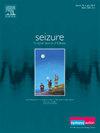Autoimmune-associated epilepsy – a challenging concept
IF 2.7
3区 医学
Q2 CLINICAL NEUROLOGY
引用次数: 0
Abstract
The current International League Against Epilepsy (ILAE) definition and classification guidelines for the first time introduced the category of immune-mediated focal epilepsy in addition to structural, genetic, infectious, and metabolic aetiologies. Moreover, the ILAE Autoimmunity and Inflammation Taskforce recently provided a conceptual framework for the distinction between acute “provoked” seizures in the acute phase of autoimmune encephalitis from chronic “unprovoked” seizures due to autoimmune-associated epilepsy. The first category predominately applies to those autoimmune encephalitis patients with autoantibodies against cell surface neural antigens, in whom autoantibodies are assumed to exert a direct ictogenic effect without overt structural damage. These patients do not exhibit enduring predisposition to seizures after the “acute phase” encephalitis, and thus do not fulfil the definition of epilepsy. The second category applies to those autoimmune encephalitis patients with autoantibodies against intracellular neural antigens and Rasmussen's encephalitis, in whom T cells are assumed to cause epileptogenic effects through immune-inflammation and overt structural damage. These patients do exhibit enduring predisposition to seizures after the “acute phase” of encephalitis and thus fulfil the definition of epilepsy. AAE may result from both, ongoing brain autoimmunity and associated structural brain damage according to the current ILAE definition and classification guideline. We here discuss the difficulties of this concept and suggest an unbiased translationally validated and data-driven approach to predict in an individual encephalitis patient the propensity to develop (or not) AAE and the cognitive and behavioural outcome.
自身免疫相关性癫痫--一个具有挑战性的概念。
目前的国际抗癫痫联盟(ILAE)定义和分类指南首次在结构性、遗传性、感染性和代谢性病因之外引入了免疫介导的局灶性癫痫类别。此外,ILAE 自身免疫和炎症工作组最近提供了一个概念框架,用于区分自身免疫性脑炎急性期的急性 "诱发 "癫痫发作与自身免疫相关性癫痫引起的慢性 "非诱发 "癫痫发作。第一类主要适用于具有针对细胞表面神经抗原的自身抗体的自身免疫性脑炎患者。这些患者在脑炎 "急性期 "后并不表现出癫痫发作的持久倾向,因此不符合癫痫的定义。第二类适用于具有针对细胞内神经抗原的自身抗体的自身免疫性脑炎患者和拉斯穆森脑炎患者,假定T细胞通过免疫炎症和明显的结构损伤引起致痫效应。这些患者在脑炎 "急性期 "后确实表现出癫痫发作的持久倾向,因此符合癫痫的定义。根据目前的 ILAE 定义和分类指南,AAE 可能同时由持续的脑自身免疫和相关的脑结构损伤引起。我们在此讨论了这一概念的难点,并提出了一种无偏见的、经过翻译验证的、数据驱动的方法,用于预测个别脑炎患者发生(或不发生)AAE的倾向以及认知和行为结果。
本文章由计算机程序翻译,如有差异,请以英文原文为准。
求助全文
约1分钟内获得全文
求助全文
来源期刊

Seizure-European Journal of Epilepsy
医学-临床神经学
CiteScore
5.60
自引率
6.70%
发文量
231
审稿时长
34 days
期刊介绍:
Seizure - European Journal of Epilepsy is an international journal owned by Epilepsy Action (the largest member led epilepsy organisation in the UK). It provides a forum for papers on all topics related to epilepsy and seizure disorders.
 求助内容:
求助内容: 应助结果提醒方式:
应助结果提醒方式:


